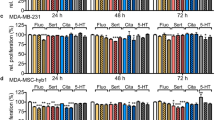Abstract
Objectives:An association of increased risk of ovarian cancer with use of antidepressants or benzodiazepine tranquilizers has been reported from a case–control study. We assessed the association between ovarian cancer risk and the use of tricyclic antidepressants, selective serotonin reuptake inhibitors (SSRIs), phenothiazine antipsychotics, and benzodiazepines, in data from the Case–Control Surveillance Study.
Methods:From 1976 through 1998, data were collected from hospital patients in Boston, New York, Philadelphia, and Baltimore based on demographic factors, reproductive and medical history, and medication use. In the present analyses, cases of epithelial ovarian cancer (n = 748) were compared with cancer controls (n = 1496) and noncancer controls admitted for trauma and acute infection (n = 1496). We estimated Mantel–Haenszel odds ratios adjusted for age, study center, and year of interview.
Results:Odds ratios for regular use (at least 4 days/week for at least 1 month) were compatible with 1.0 for every drug class. For tricyclics and benzodiazepines the upper 95% confidence limits were less than 1.6. For phenothiazines the upper limit was 2.6 with cancer controls and 1.4 with noncancer controls. Only five cases used SSRIs, yielding unstable results. Odds ratios were not increased among women who had used any drug class for at least 5 years, nor among women who had first used them 10 or more years previously.
Conclusions:These data do not support an association between regular use of any of the drugs under study with ovarian cancer risk.
Similar content being viewed by others
References
Harlow B, Cramer D (1995) Self-reported use of antidepressants or benzodiazepine tranquilizers and risk of epithelial ovarian cancer: evidence from two combined case-control studies (Massachusetts, United States). Cancer Causes Control 6: 130–134.
Harlow BL, Cramer DW, Baron JA, Titus-Ernsto. L, Greenberg ER (1998) Psychotropic medication use and risk of epithelial ovarian cancer. Cancer Epidemiol Biomarkers Prev 7: 697–702.
Tzonou A, Day NE, Trichopoulos D, et al. (1984) The epidem-iology of ovarian cancer in Greece: a case-control study. Eur J Cancer Clin Oncol 20: 1045–1052.
Tzonou A, Polychronopoulou A, Hsieh C-C, Rebelakos A, Karakatsani A, Trichopoulos D (1993) Hair dyes, analgesics, tranquilizers, and perineal talc application as risk factors for ovarian cancer. Int J Cancer 55: 408–410.
Rosenberg L, Palmer J, Zauber A, et al. (1995) Relation of benzodiazepine use to the risk of selected cancers: breast, large bowel, malignant melanoma, lung, endometrium, ovary, non-Hodgkin's lymphoma, testis, Hodgkin's disease, thyroid, and liver. Am J Epidemiol 141: 1–8.
Shapiro S (1994) Case-control surveillance. In: Strom BL, ed. Pharmacoepidemiology, 2nd edn. Chichester, UK: John Wiley & Sons, pp. 301–322.
Mantel N, Haenszel W (1959) Statistical aspects of the analysis of data from retrospective studies of disease. J Natl Cancer Inst 22: 719–748.
Sloley BD, Kah O, Trudeau VL, Dulka JG, Peter RE (1992) Amino acid neurotransmitters and dopamine in brain and pitu-itary of the goldfish: involvement in the regulation of gonadotropin secretion. J Neurochem 58: 2254–2262.
Bedran-de-Castro JC, Petrovic SL, McCann SM (1990) Involve-ment of beta-adrenergic receptors in the di.erential release of gonadotropins in acutely orchidectomized rats. Braz J Med Biol Res 23: 1025–1027.
Kannisto P, Owman C, Walles B (1985) Involvement of local adrenergic receptors in the process of ovulation in gonadotropin-primed immature rats. J Reprod Fertil 75: 357–362.
Aguilar E, Ranchal A, Aguilar R, Pinilla L (1993) Gonadotropin and prolactin secretion in prepubertal female rats treated with 8–hydroxy-2–(di-n-propylamino) tetralin. J Neural Transm Gen Sect 94: 165–173.
Steingart AB, Cotterchio M (1995) Do antidepressants cause, promote, or inihibit cancers? J Clin Epidemiol 48: 1407–1412.
IARC Working Group on the Evaluation of Carcinogenic Risks to Humans (1996) Benzodiazepines and Related Compounds and Phenytoin, vol. 66: Some Pharmaceutical Drugs. Lyon: Interna-tional Agency for Research on Cancer, pp. 37–234.
Motohashi N, Gollapudi S, Emrani J, Bhattiprolu K (1991) Antitumour properties of phenothiazines. Cancer Invest 9: 305–319.
Rights and permissions
About this article
Cite this article
Coogan, P.F., Rosenberg, L., Palmer, J.R. et al. Risk of ovarian cancer according to use of antidepressants, phenothiazines, and benzodiazepines (United States). Cancer Causes Control 11, 839–845 (2000). https://doi.org/10.1023/A:1008982417022
Issue Date:
DOI: https://doi.org/10.1023/A:1008982417022




